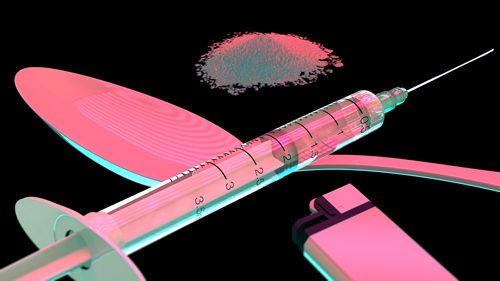Classified by The Drug Enforcement Administration as a Schedule 1 drug, heroin is a dangerous and highly addictive substance. Schedule 1 drugs are those that are controlled and do not have any medical use in the United States. A central nervous system depressant, heroin is a powerful opioid. It has a high potential for abuse and causes severe physical and psychological dependence.
What Exactly Is Heroin?
Heroin is an opioid drug processed from morphine derived from certain opium poppy plants grown in Southwest and Southeast Asia, Columbia, and Mexico. When heroin enters the brain, it binds to the mu-opioid receptors that regulate pain, pleasure, and feelings of well-being. Since this drug is a central nervous system depressant, it slows down breathing, lowers blood pressure, reduces body temperature, and causes an irregular heartbeat. The effects can cause the person to lose consciousness, go into a coma, or stop breathing. Heroin can be fatal.
Heroin can be sold as a fine white powder, brown powder, coarse off-white granules, tiny pieces of light brown pieces, or a sticky black goo-like substance known as black tar heroin. Nicknames for heroin are many, including black tar, brown sugar, H, Big H, China white, Dragon, Horse, White horse, Snowball, Hell dust, Snow, and Skag.
Heroin Addiction
When a person uses heroin, they get a feeling of relaxation, warmth, and detachment. Their anxiety lessens. The effects of heroin happen quickly. If the person injects or smokes the drug, they feel an almost instant rush of euphoria. The effects of heroin can last for several hours, depending on how much the person used and how they took the drug. The feelings of overall well-being, happiness, and pleasure heroin causes make the user want to use it again. As they continue to use the drug, tolerance develops, and they need to use more and more of the drug to achieve the high they want. As they continue to abuse the substance, dependence and addiction follow.
Withdrawal
Heroin withdrawal occurs when a person suddenly stops or greatly reduces the amount of heroin they use. Not everyone experiences the same withdrawal symptoms. The duration and severity of withdrawal symptoms vary based on a number of various factors that include:
- How long the person was using heroin
- The potency and dose they were using
- How the individual took the heroin (injected, smoked, snorted)
- Whether or not they were using other drugs or alcohol in addition to heroin
- Whether or not they have a history of previous addictions, withdrawal symptoms, or relapse
- The person’s history of any mental health issues, co-occurring disorders, and physical health
The half-life of heroin is very short, ranging from two to six minutes. This means that withdrawal symptoms can begin in as little as six hours after a person takes their last dose. Symptoms reach their peak between 24 to 48 hours and resolve in four to ten days.
In most cases, withdrawal is not life-threatening unless the individual experiences complications. Withdrawal symptoms range from mild to severe. Many people describe the symptoms as feeling like they have a severe case of the flu, with muscle aches, abdominal cramps, nausea, diarrhea, chills, and sweating. A person may have a runny nose, teary eyes, dilated pupils, and tremors. Depression, panic attacks, anxiety, restlessness, and agitation are common. They may experience difficulty breathing, elevated blood pressure, rapid heart rate, and dehydration.
Potentially Fatal Withdrawal Symptoms
Withdrawal symptoms that can be life-threatening or fatal if there are complications include:
- Cardiac arrhythmia
- Severe dehydration resulting in heart failure
- Hypovolemic shock
- Kidney failure
- Hypernatraemia (extremely high blood sodium levels)
- Seizures
Withdrawal Timeline
Day 1 and 2: Symptoms begin within six hours and intensify over the first 48 hours.
Day 3 – 5: Symptoms of acute withdrawal generally peak on the fourth day.
Day 6 – 10: Acute withdrawal ends as symptoms begin to slowly taper off.
Post-Acute Withdrawal Syndrome (PAWS): Symptoms of post-acute withdrawal syndrome can last for weeks, months, or years. Common symptoms are depression, anxiety, insomnia, fatigue, and irritability.
Help Is Available
Addiction is a treatable, chronic disease. It can affect anyone. If you or a loved one is struggling with an addiction to heroin, help is available. At Canyon Vista Recovery Center, located in Mesa, Arizona, our caring professionals will help you achieve your goal of sobriety using a combination of medical, psychiatric, holistic, and clinical approaches. Our doctors can help you detox from heroin safely and with minimal discomfort. Following detox, residential treatment provides the structure, therapy, education, and community that will help you develop the self-awareness and healthy habits to support a long-term recovery.
Are you or a loved one looking for a heroin addiction recovery program in Mesa, AZ? Learn more about programs offered at Canyon Vista Recovery Center. Contact us at (888) 979-1840





